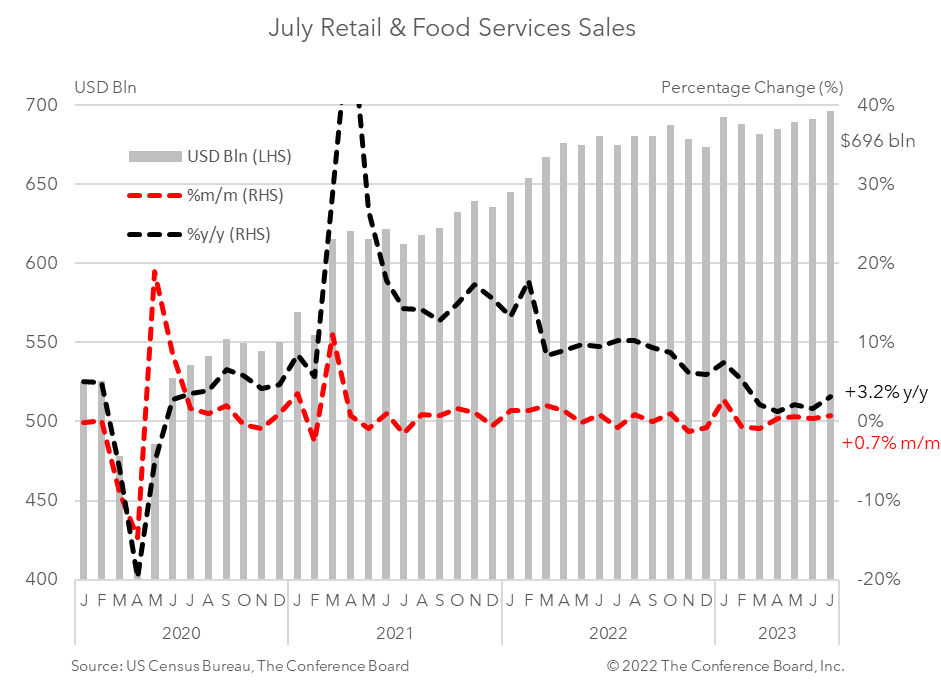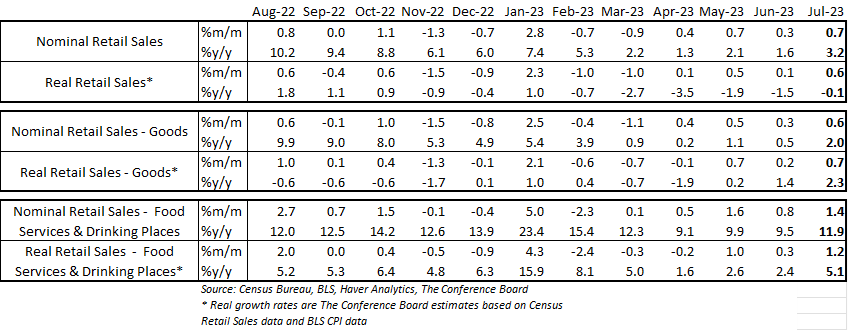-
Email
Linkedin
Facebook
Twitter
Copy Link

Loading...
Retail sales jumped in July as US consumers continued to open their wallets. Consumer spending was up 0.7 percent month-over-month (MoM), well above the consensus expectation of 0.4 percent. Adjusted for inflation, sales were up 0.6 percent from May.* These data showcase the continued resilience of US consumers amid high interest rates and elevated inflation. Tight labor markets, rising wages, and rising consumer confidence are driving the US consumer to keep spending. The Conference board forecasts that US real consumer spending** will grow by about 2.0 percent year-over-year in 2023, vs. 2.7 percent in 2022. This trend has buttressed the US economy and prevented a widely anticipated recession from occurring. While we acknowledge that a soft landing for the US economy is rising, we believe that a very brief economic downturn starting in late 2023 or early 2024 is the more probable outcome. Consumer demand for goods rose 0.6 percent in July from the month prior in nominal terms. Spending on motor vehicles and parts fell by -0.3 percent in July from June, while retail sales excluding motor vehicles rose by 0.9 percent. Spending at gasoline stations rose 0.4 percent from the month prior due to rising oil prices. Building materials sales rose by 0.7 percent. Retail sales less motor vehicles, gasoline, and building supplies (known as “Retail Control”) rose by 1.0 percent from the previous month. Nonstore retail sales growth rose to 1.9 percent in July, the fastest rates seen since last December. When adjusting goods spending for CPI inflation, the real growth rate was about 0.7 percent from the previous month.* Meanwhile, spending at food services and drinking places rose by 1.4 percent month-over-month in July. After adjusting for CPI inflation the real growth rate was about 1.2 percent from the previous month.* * Real growth rates are The Conference Board estimates based on Census Retail Sales data and BLS CPI data. ** The Conference Board’s forecast on US consumer spending is based on Personal Consumption Expenditures which is a broader gauge of spending than Retail Sales.

Retail Sales Show Consumers Stock Up ahead of Tariffs
April 16, 2025
US Seeks Shipbuilding Revival, Muting of China Dominance
April 14, 2025
March CPI May Hint at Consumer Pullback as Tariffs Rise
April 10, 2025
The US-China Trade War Escalates
April 09, 2025
Reciprocal Tariffs Will Weaken US and Global Economies
April 03, 2025
Charts
Preliminary PMI indices show no change in weak DM growth momentum in November
LEARN MORECharts
Members of The Conference Board can access all underlying data of the Job Loss Risk Index by Industry in this Excel workbook.
LEARN MORECharts
While a US recession appears to be imminent, it will not look like any other in recent history.
LEARN MORECharts
CEOs’ views of current and future economic conditions remain pessimistic as they prepare for near-inevitable US and EU recessions.
LEARN MORECharts
The US economy appears to be on the precipice of recession.
LEARN MORECharts
Measure of CEO Confidence declined for the fifth consecutive quarter in Q3 2022 and has hit lows not seen since the start of the COVID-19 pandemic in 2020.
LEARN MOREPRESS RELEASE
US Leading Economic Index® (LEI) Fell in March
April 18, 2024
PRESS RELEASE
US Consumer Confidence Little Changed in March
March 26, 2024
PRESS RELEASE
US Leading Economic Index® (LEI) Inched Up in February
March 21, 2024
PRESS RELEASE
US Consumer Confidence Retreated in February
February 27, 2024
PRESS RELEASE
US Leading Economic Index® (LEI) Fell Further in January
February 20, 2024
PRESS RELEASE
CEO Confidence Improved in Q1 2024
February 08, 2024
